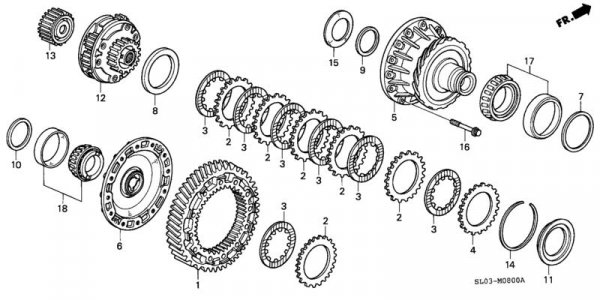Wrong. Either horsepower or weight loss will give better acceleration than gearing changes.
It probably also depends on the gear change. I would probably agree with you if you are solely comparing the US to JDM gear ratio.
But if you are referring to changing final drives:
And it is my experience that MOST of the tracks I've experienced would best be served by the USIM stock gears with the USIM stock 4.062 R&P.
4.06 - 4.23 isn't nearly as big as a 4.06 - 4.55 gear change. Having your car geared to 180+mph (4.06) while never exceeding 150mph leaves a lot on the table in terms of efficiency and keeping the motor in the optimum powerband (from gearing) than having the final drive dictated by the top speed you intend on going. Ideally on a track you want to be at redline in the highest gear at the end of the longest straight. Here's a great quote/explanation:
"Changing the gear ratio in the final drive does two things. It changes engine speed relative to ground speed, and it changes the available torque at the drive wheels relative to engine torque. For achieving maximum accelleration you need the highest torque a the drive wheels, to which end you would want to increase the final drive ratio. But the magic red line on the tachometer (wherever you chose to paint it) dictates the highest speed allowable for the engine. The trick then is to use the highest gear ratio possible while not allowing the engine to run past red line at the fastest point on the race track. So on a short track where the car will not be moving so fast, it is advantageous to use a higher ratio final drive for improved accelleration. But for a longer track, especially with longer straightaways, the final drive ratio must be lowered enough to prevent over reving of the engine. To wit, it is common to swap out the final drive gearing between race dates."
Because of this, I don't think the 4.06 final drive is beneficial in most (especially NA) cases. In Grand-Am, the sanctioning body changes the competitiveness of cars (their outright SPEED) by changing their final drive ratios. The Mustang for instance was slowed down greatly by lowering their final drive ratio and making 5th gear almost useless and making 6th gear completely useless (since the car is now geared to over 200mph).
Not true. I use my car on racetracks where roughly 65-80 mph is the "sweet spot", the speeds that are often used through the corners and long stretches of the track (such as Mid-Ohio all the way from the end of the back straight to the chute). An NSX with stock gears can use second gear in those sections and is simply faster than an NSX with short gears which is stuck using third.
So you've tracked NSXs with both US and JDM gear sets. Other than Mid-Ohio (which you have repeated alot) which tracks have you been on that the US ratio is better at? While the US gear set can be better for certain tracks, i'm not convinced that the final drive is the best/fastest for almost any track in the US.
After a quick look:
Miller Motorsports Park (Outer loop): 4 turns <55mph
Mid Ohio (standard course): 4 turns <55mph
-after the back straight, you never get above 73mph (redline in 2nd gear for JDM gears) except for over the crest in Turn 10 and approaching Turn 11 which leads to Thunder Valley. Even here, upshifting won't slow the car down too much since you're not in the gear very long anyway before you're braking for T11. The apex of T-11 is <60mph and uphill. The higher rpm of the JDM 2nd gear would probably see an advantage over the US 2nd gear ratio coming out of this corner with better acceleration, and would probably see closer to redline in 3rd before Turn 12 compared to the US 3rd gear which will have ~10mph of unused potential and RPM that is not taken fully advantage of.
NJ Motorsports Park: 3 turns <50mph
VIR: 3 turns <50mph
Due to the frequency of lowspeed corners on various tracks, there is a pretty good argument for the shorter JDM 2nd gear when compared to the US gear ratio (both with 4.06 final drives).
***For most people, you should look at a few different things to help you decide what to do.
-Does cruising RPM matter to you? 4.55 will have a much higher RPM than a 4.06 for freeway use.
-Does a high top speed matter to you? 4.06 is geared to 180+mph. If you will never see that then it should be a irrelevant factor to you.
-Does outright speed on a track important to you?
-Is improved acceleration important to you?
For me:
1) Cruising RPM is important since I do a lot of freeway driving. I did not want the RPM to be very high. 2) Top speed does matter since I might drive the car in events or on tracks where I can reach these speeds. 3)Outright speed on track is important but a HUGE factor for me is that my car will be turbocharged with over 500hp and the longer 4.06 final drive will be advantageous with this much power. 4) Improved acceleration is important but again, due to the turbo, it is not directly comparable anymore.
Because of this, I decided to go with the JDM gear ratio and 4.06 Final drive for my turbocharged setup and MY intended application. If this was going to be an all-motor NA car and just for track use, I would probably go with the JDM ratio and a 4.55 final drive because the car would never see over 165mph.










